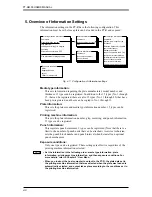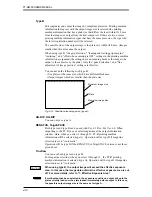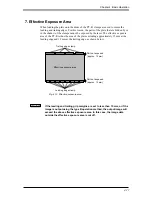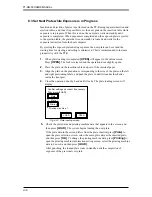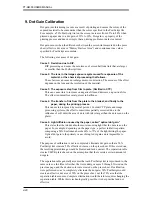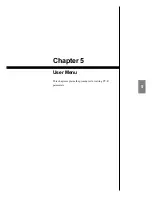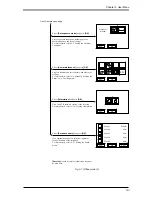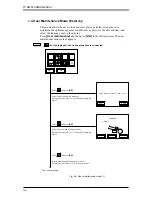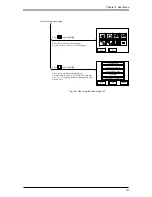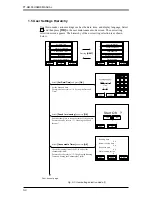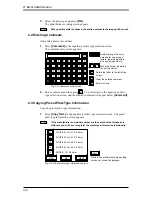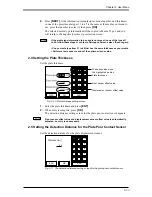
PT-R4300 USERS MANUAL
4-20
9. Dot Gain Calibration
Dot gain (dot thickening) occurs as a result of printing and causes the colors of the
exposed material to become darker than the colors specified in the PostScript file.
For example, a 50% PostScript tint on the screen increases from 65% to 80% when
printed on paper due to a dot gain of 15% to 30%. Dot gain is a property of the
printing process and does not imply that a printing problem or defect occurred.
Dot gain occurs when the differences between the screen tint measured on the press
sheet (effective dot area or “Murray Davices Area”) and continuous tone values
specified by PostScript accumulate.
The following are causes of dot gain:
Cause 1: Deviation due to RIP.
RIP processing can cause the occurrence of screen halftone tints that are larger
or smaller than the PostScript tints.
Cause 2: The lens in the image exposure system used for exposure of the
material, or the chemical processing that follows.
These factors can cause dot enlargement or contraction. The amount of the effect
depends on the lens and the resolution of the material.
Cause 3: The exposure step from film to plate. (Omitted in CTP)
This can cause tints to increase on negative film and decrease on positive film.
The effect is normally several percent in halftones.
Cause 4: The transfer of ink from the plate to the blanket, and finally to the
paper, during the printing process.
This causes ink to spread by several percent. In older CTP plate and image
processing systems, the effect is sometimes partially corrected due to the
influence of soft dots (the area of dots with ink is larger than the dots seen on the
plate).
Cause 5: Light diffusion caused by the paper, called “optical dot gain.”
This states that the ink dot absorbs more incoming light that the dot area on the
paper. For example, depending on the paper type, a perfect ink lattice pattern
composing a 50% Euclidean absorbs 60% to 75% of the light hitting the paper.
Optical dot gain is the primary cause of single dot gain and is impossible to
avoid.
The purpose of calibration is not to completely eliminate dot gain so that a 50%
PostScript tint creates a 50% effective dot area on the press sheet. If this were done,
the resulting printed image would be blurred and lack contrast. The separation table
creates CMYK plates based on the assumption that there exists a certain amount of
dot gain.
The separation table generally assumes that each PostScript tint is reproduced to the
same value on the film. After that, the tints undergo causes 2 through 5 listed on the
previous page, and the desired colors are created on the press sheet. If calibration
were performed so as to completely eliminate the dot gain, 50% PostScript would
create an effective dot area of 50% on the press sheet, not the 70% area that the
separation table assumes. Complete elimination would therefore require changing the
separation table. While this is technologically possible, it is not practical and not
effective.
Summary of Contents for PLATE RITE 4300
Page 10: ...x...
Page 11: ...Chapter 1 Ensuring Safety 1 This chapter gives information necessary for safe use of the PT R...
Page 26: ...PT R4300 USERS MANUAL 1 16 End of Chapter 1...
Page 38: ...PT R4300 USERS MANUAL 3 8 End of Chapter 3...
Page 39: ...This chapter explains the basic procedures for operating the PT R Chapter 4 Basic Operation 4...
Page 60: ...PT R4300 USERS MANUAL 4 22 End of Chapter 4...
Page 61: ...This chapter explains the procedures for setting PT R parameters Chapter 5 User Menu 5...
Page 122: ...PT R4300 USERS MANUAL 5 62 End of Chapter 5...
Page 157: ...This chapter explains this typical PT R problem and the solutions Chapter 8 Jamming 8...
Page 163: ...This chapter gives technical information on the PT R Chapter 9 Technical Information 9...



